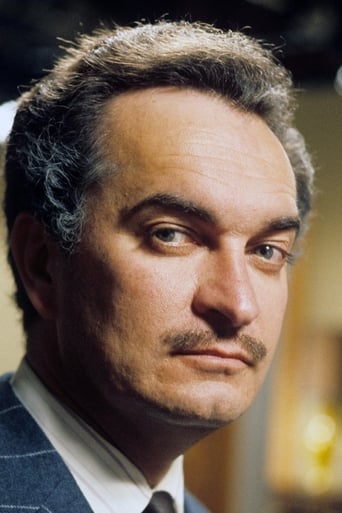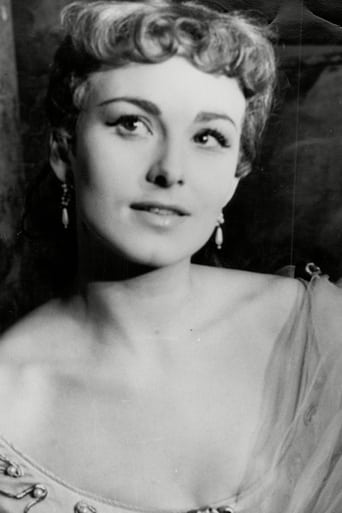Stometer
Save your money for something good and enjoyable
UnowPriceless
hyped garbage
Jonah Abbott
There's no way I can possibly love it entirely but I just think its ridiculously bad, but enjoyable at the same time.
Geraldine
The story, direction, characters, and writing/dialogue is akin to taking a tranquilizer shot to the neck, but everything else was so well done.
Howard Schumann
Strong direction and a superb cast make Peter Hall's 1968 version of William Shakespeare's comedy A Midsummer Night's Dream my favorite version of the film, and one of my favorite Shakespeare adaptations of any film. (I understand that the DVD release does not do justice to the film, so if you are renting, I would suggest the VHS version). The film is performed by the Royal Shakespeare Company and the cast is composed of superb actors, many of whom did not become stars until years later. These include: including Judi Dench as the Fairy Queen, a scantily clad Tatania, Diana Rigg as Helena, a young Helen Mirren as Hermia, the lover of Lysander (David Warren), Ian Holm as the inimitable Puck, Paul Rogers as the most believable Bottom I've seen, and Ian Richardson as the Fairy King Oberon.While the film had a limited budget, the clarity of its presentation may be one of the few adaptations of the Bard that doesn't need subtitles to fully appreciate Shakespeare's poetry. As far as the story, it is a light-hearted and enchanting comedy that uses magic to create a mysterious, mystical atmosphere,. Shakespeare populates the woods outside of Athens with mischievous, but good hearted fairies who mistakenly create unnecessary conflict, then make amends. The supernatural is the essential element that runs throughout the play and Shakespeare uses magic both to confuse the characters, and then resolve their bewilderment. Each character experiences the magic differently. Bottom finds his wondrous dreams to be magical, while the lovers, arguably the most impacted by magic, remember it only as a bad dream. Titania finds magic in her love of a little boy, and Oberon embraces the magic of the supernatural elements in the seemingly natural world. In this play, Shakespeare suggests that the world of the magical fairies is not separate from nature, but a part of it, even though Hall separates the fairies from the rest of the characters by depicting them in shades of green. A Midsummer Night's Dream also displays the author's knowledge of Greek mythology by characters such as Theseus, the Duke of Athens, a mythical founder-king of Athens, and his bride Hippolyta, an Amazonian queen who owned a waist belt that signified her authority as queen of the Amazons. Additionally, two other characters, Oberon and Titania, can be seen as similar to Zeus and Hera, and Puck can be compared to Eros, the Greek god of sexual love and beauty with the flower that Puck puts on characters' eyes is comparable to Eros' golden arrows. The play also owes a large debt to Ovid's "Metamorphoses," likely used in the translation by Arthur Golding, the uncle of Edward de Vere, the Earl of Oxford. The early 20th century delineator of classical mythology, Robert Kilburn Root, says that the whole character of Shakespeare's mythology is essentially Ovidian and that "Shakespeare himself has shown that he was proud to be Ovid's successful ape." As in Ovid's use of a story-within-a story, Shakespeare uses the tale of Pyramus and Thisbe as a play-within-a play for entertainment at the wedding of Theseus and Hippolyta, a rollicking good time. Metamorphosis, a theme central to Ovid is clearly represented by Bottom's transformation into an ass. "Man is but an ass if he go about t'expound this dream," he says, unable to fathom the magical happenings that have affected him as anything but the result of sleep. Shakespeare is also interested in the actual workings of dreams, in how events occur without explanation, time loses its normal sense of flow, and how the impossible occurs as a matter of course. One aspect of the play, not often noted, is how Shakespeare's depiction of women challenged the convention of the time. Hippolyta's role in her relationship with Theseus is striking. The fact that she stands up to Theseus when she disagrees with him in Act V is extremely significant. In Shakespeare's time, it was common practice for the wife to be the submissive, silent partner in a relationship. Hippolyta's first words in the play evidence the prevalence of dreams ("Four days will quickly steep themselves in night, / Four nights will quickly dream away the time"), and various characters mention dreams throughout (Act 1, Scene 1). Animal spirits also pervade the play, including references to owls, ravens, and spiders. In Act 2, Scene 2, Puck delivers a charm to protect the sleeping Titania from tiny creatures common in England associated with the fates, the weaver of illusion, and the women who wove the threads of life, all harmless, though once thought to be venomous."Weaving spiders, come not here; Hence, you longlegged spinners, hence! Beetles black approach not near; Worm nor snail, do no offence."At the end of the play, Puck extends the idea of dreams to the audience members themselves, saying that, if they have been offended by the play, they should remember it as nothing more than a dream. In spite of being a product of the 60s with its mini-skirts and boots, A Midsummer Night's Dream has a fresh and contemporary look and audiences of today would feel right at home with the film's use of jump cuts, and and-held camera (presumably a debt to director Richard Lester). It is a "feel-good" story that is neatly resolved but I certainly would not have wanted it to be any other way, and I suspect Elizabethan audiences would not have either.
paybaragon
This is not only the best version of the play available on film, it is easily one of the five best Shakespearian films of all (at least in English).The fact that it was made on less than a shoestring budget is totally irrelevant. Whether or not there are any special effects, the photography by the renowned Peter Suschitzky ("Dead Ringers", "Empire Strikes Back", "Spider") is excellent. It's not only pictorial, but contributes greatly to the spontaneous, irreverent, slapstick-esquire approach to the whole production, which Peter Hall and his marvelous actors worked so hard to achieve. The locations are also ideal, given the modernized, anglicized look of the production.Director Hall's interpretation of the play comes as close to 'perfection' as an enthusiast of the Bard could possibly ask for. He refuses to reduce the play to an erotic fantasy, as so many other have done (i.e. the 1999 film), and he rejects the even more common temptation to turn it into a loud, garish costume-ball. In other word, Hall presents the play as Shekespeare wrote it.It relies for its appeal on marvelous words and gestures, not on costumes and special effects.As for the cast, one only need to look at the big names on the list to see that this production was literally one-of-a-kind. Actually the least famous major player in this company is the one most worthy of note: Paul Rogers, a wonderful character actor and a frequent collaborator of Alec Guinness, is quite possibly the best Bottom that most of us (in this day and age) are ever likely to see. Both Cagney and Kevin Kline were terrific in the major films, but Paul Rogers IS Bottom.It says something about both film audiences and readers that the 1935 Warner Bros. film with James Cagney is rated more highly on the IMDb than this production. In that pretty but vapid collection of songs and dances, you could hardly hear any of Shakespeare's words, and if you could you would have to cringe, since almost none of the actors could adequately speak the lines. Cagney was good, but the rest was silence. GO WITH THIS VERSION INSTEAD! Fortunately, it was recently made available on DVD.
Jon Kolenchak
This film has a dream cast. Diana Rigg, Judi Dench, Helen Mirren, and Paul Rogers are especially fine. Yet, the film moves clumsily along with all the cinematographic finesse of a home video. So much of the production values of this film are just plain sloppy. Sloppy makeup and sloppy attention to costume detail are just the beginning of the list of faults. Exactly when was this story supposed to happen? It could have been an Elizabethian period piece, yet methinks it could have been the 1960's based on the women's short skirts and very 'mod' boots. There were touches of the directing style of Ed Wood, also. We enter the forest and it's dark. A few scenes later, the sun is shining, then it's dark again. I can't let this review go by without echoing another reviewer's comment -- What exactly were they doing to get so dirty?!?I did find a way to completely enjoy this film. Don't watch it -- listen to it. It works much better as an audioplay than as a film.
WeaselWoman13
This adaptation of "A Midsummer Night's Dream" seemed like it was trying to be a liiiittle too arty. It resulted in looking downright silly to me. Here's a rather lengthy list of reasons why. First of all, the male characters' costumes looked like simple modern suits with ruffly collars added. The females were all wearing extremely short mini dresses, making it very clear that the movie was made in the 60s.Puck, Titania, and Oberon are running around naked and green. I don't mind the naked part, but...must they be green? It bothered me slightly - it's a neat way to think of fairies and spirits, being green. But if they were going to take that route, they could have done a slightly better makeup job - the makeup seemed thick and shiny, stopped on certain parts of the body, and also seemed to be irritating Oberon's eyes - they looked redder-rimmed and puffier through each shot.The lovers get muddier and muddier as they go through the woods. This is slightly exaggerated. I mean, what were they DOING? It wasn't THAT muddy, and they weren't falling down on their face every few minutes! People simply don't get that muddy walking in the woods!When we did this play at the school, it was stressed that we should USE our body gestures and hands, and so after having that pounded into my mind, the actors' almost completely inanimate bodies really bugged me, and Oberon seemed to be telling himself "Must not move face must not move face must not move face..."Puck's tongue thing was really odd, and the way the spirits teleported around...priceless! And don't you love it when all the little fairies come jumping out of the trees and the camera flashes around? Deliciously weird.Speaking of the camera - how about that camera work? It reminds you a little of those "Blair Witch Project" trailers.And what kind of animals were those in that forest? Where did they get those sound effects?However, I did love the rude mechanicals. They were just as I would imagine them (and I recognize Snug from Keeping Up Appearances!). And Puck went on to be Bilbo Baggins - it's so perfect! All the actors were good - it's just that the film was put together so strangely. It was an extremely interesting approach, but they got a little too creative. 5/10.




